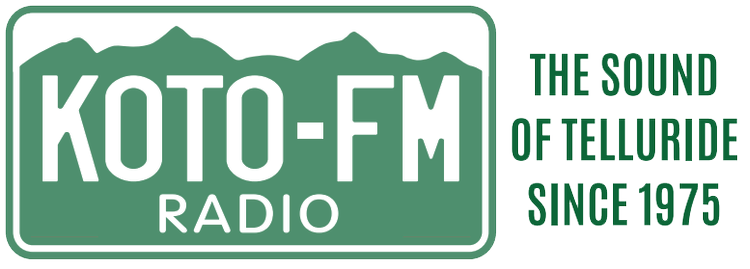By Julia Caulfield
Telluride has a new mural on Main Street. The piece, called Rise, was created by Gregg Deal, a Native artist, and member of the Pyramid Lake Paiute Tribe. Deal spoke with KOTO News about the mural and the importance of Indigenous representation in art and culture.
Julia Caulfield (JC): How did you get started as an artist? I know a lot of your work focuses on Indigenous identity and mixing that with pop culture, so I was also wondering if you can talk a little bit about where the inspiration for your work comes from?
Gregg Deal (GD): I’ve been doing artwork forever, to the detriment of my high school career, I spent a lot of time drawing and a lot of time creating, and I’ve been fortunate enough to come into contact with people who have helped me along in figuring out those things. It’s not just the craft, it’s also the message and the voice that comes out in it. As a Native person, those voices are always there. I would even go so far as to say they’re kind of always there for every Native person in one way or another, and so it becomes trying to figure out the way to manifest that into the work in a way that makes sense, and in a way that’s comprehensive for anybody, and how to enact change in the understanding of Native people in our own homeland.
JC: The mural in Telluride is your piece called Rise. It’s a portrait of a young, Native woman with her eyes looking up to the sky and the word “rise” above her head. What was the process like of creating the piece and how did you come up with the production of it?
GD: Well, first and foremost that’s my oldest daughter. She’s thirteen and for some reason when I use her face, or illustrate her face, she’s older than she looks. There’s also some deliberate use in using a woman in those ways as well. The sort of resurgence and understanding of the importance of Indigenous women in our communities and also the way Indigenous women have traditionally and are still often victimized in ways that are horrific, sexual assault, and there’s a huge issue of missing and murdered Indigenous women in Indian Country right now, and an effort to try to help people understand that that’s a really serious thing that’s happening and affecting our communities. But amidst all that, I wanted to create something that was a little more general, something that anybody could connect with, that is appropriate with the political and social climate of today. Sometimes “rise” could be a political call, but “rise” could also just be something as simple as ‘get up this morning and go do good, do better than you did yesterday, and continue to move forward’. She is Indigenous and there are some aspects of the image that point to that, but they might not be very obvious to other people, and I did that on purpose because I think that it’s incredibly important to sometimes understand that there’s a general message that applies to all these things, that are rooted in Indigeneity, but also can be things that exist amidst other people.
JC: There are people who might not have a lot of experience with Native people, or culture, outside of portrayals that we see in the media. To you, does that change the piece at all, or what your trying to say with it, or the importance of it?
GD: No, not at all. In terms of a white audience, versus an Indigenous audience, the truth is its still Indian land, traditional Indian land, which means that is the homeland of Indigenous People. So, representation and inclusion of Indigenous faces, and Indigenous bodies, and Indigenous issues, it should be, and can be everywhere because it’s something that affects these places. The narrative that has been given to the majority of Americans about our existence is very much rooted in falsehoods, and romanticism, and stereotype and so in my mind to have something that not only is Indigenous, but speaks to modern Indigenous existence, and to put those in plain sight, I think is incredibly powerful.
JC: There’s obviously going to be some people coming through Telluride for the weekend and maybe see the piece once or twice, and then there’s people who live here year round and walk past it almost every day. What do you hope that people get from looking at the piece?
GD: I think it’s a very simple call to action that is ambiguous enough that it can apply to a lot of different things. But I think - just like any piece of art, public art, murals, and even museums that hold art, and galleries that show art - that these become places of reflection and solitude; that there’s a sense of ownership that goes to those things. I hope that folks feel a sense of ownership to that.
JC: Well, Gregg, thank you so much for taking that time to speak with me today about the mural that just went up in Telluride.
GD: Thanks for talking to me.
———
Gregg Deal’s Rise mural is part of Mountainfilm and will be up for the next year.

